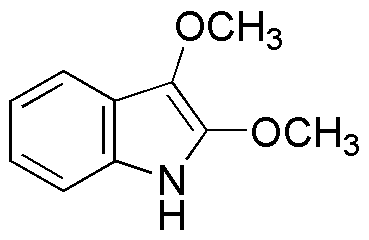2,3-Dimethoxyindole is widely utilized in research focused on:
- Pharmaceutical Development: This compound serves as a building block in the synthesis of various pharmaceutical agents, particularly in developing drugs targeting neurological disorders.
- Organic Synthesis: It is employed in organic chemistry as an intermediate for creating more complex molecules, enhancing the efficiency of chemical reactions.
- Biological Research: Researchers use it to study its effects on cellular processes, contributing to the understanding of metabolic pathways and potential therapeutic targets.
- Natural Product Chemistry: This compound is explored for its potential as a natural product derivative, which may lead to the discovery of new bioactive compounds.
- Material Science: It is investigated for its properties in creating novel materials, such as organic semiconductors, which can be used in electronic devices.
General Information
Properties
Safety and Regulations
Applications
2,3-Dimethoxyindole is widely utilized in research focused on:
- Pharmaceutical Development: This compound serves as a building block in the synthesis of various pharmaceutical agents, particularly in developing drugs targeting neurological disorders.
- Organic Synthesis: It is employed in organic chemistry as an intermediate for creating more complex molecules, enhancing the efficiency of chemical reactions.
- Biological Research: Researchers use it to study its effects on cellular processes, contributing to the understanding of metabolic pathways and potential therapeutic targets.
- Natural Product Chemistry: This compound is explored for its potential as a natural product derivative, which may lead to the discovery of new bioactive compounds.
- Material Science: It is investigated for its properties in creating novel materials, such as organic semiconductors, which can be used in electronic devices.
Documents
Safety Data Sheets (SDS)
The SDS provides comprehensive safety information on handling, storage, and disposal of the product.
Product Specification (PS)
The PS provides a comprehensive breakdown of the product’s properties, including chemical composition, physical state, purity, and storage requirements. It also details acceptable quality ranges and the product's intended applications.
Certificates of Analysis (COA)
Search for Certificates of Analysis (COA) by entering the products Lot Number. Lot and Batch Numbers can be found on a product’s label following the words ‘Lot’ or ‘Batch’.
*Catalog Number
*Lot Number
Certificates Of Origin (COO)
This COO confirms the country where the product was manufactured, and also details the materials and components used in it and whether it is derived from natural, synthetic, or other specific sources. This certificate may be required for customs, trade, and regulatory compliance.
*Catalog Number
*Lot Number
Safety Data Sheets (SDS)
The SDS provides comprehensive safety information on handling, storage, and disposal of the product.
DownloadProduct Specification (PS)
The PS provides a comprehensive breakdown of the product’s properties, including chemical composition, physical state, purity, and storage requirements. It also details acceptable quality ranges and the product's intended applications.
DownloadCertificates of Analysis (COA)
Search for Certificates of Analysis (COA) by entering the products Lot Number. Lot and Batch Numbers can be found on a product’s label following the words ‘Lot’ or ‘Batch’.
*Catalog Number
*Lot Number
Certificates Of Origin (COO)
This COO confirms the country where the product was manufactured, and also details the materials and components used in it and whether it is derived from natural, synthetic, or other specific sources. This certificate may be required for customs, trade, and regulatory compliance.


